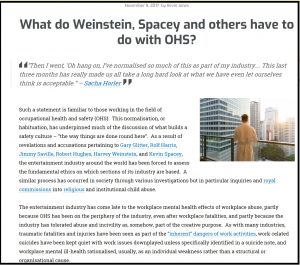At the end of September 2018 the Australian Psychological Society held its 2018 Congress. As conferences do, various media statements are released to generate interest in the speakers. One caught the attention of this blog. It was released on September 25 2018, and was called:
“Resilience isn’t enough to combat the effects of burnout, world renowned psychology expert says”
This sounded like it may look closely at the prevention of harm and SafetyAtWorkBlog was able to interview that world-renowned psychology expert,




 It is always good to see researchers assessing issues related to workplace health and safety rather than relying on overseas data. Recently researchers from the Australian Catholic University and St Vincent’s Hospital in Melbourne looked into “measuring the effectiveness of workplace health management programs” . The research adds to our understanding of these programs but the relevance to occupational health and safety (OHS) is limited.
It is always good to see researchers assessing issues related to workplace health and safety rather than relying on overseas data. Recently researchers from the Australian Catholic University and St Vincent’s Hospital in Melbourne looked into “measuring the effectiveness of workplace health management programs” . The research adds to our understanding of these programs but the relevance to occupational health and safety (OHS) is limited.
